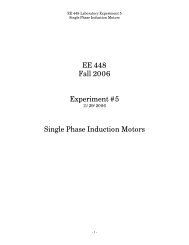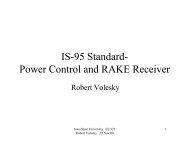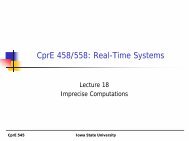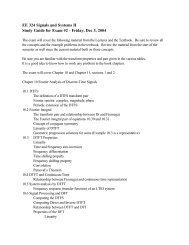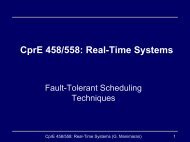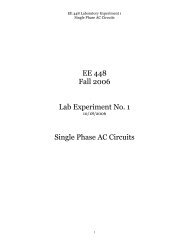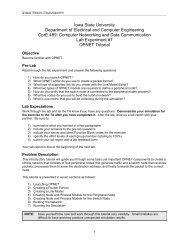Lab Experiment No. 4: Introduction to the Principle of Superposition
Lab Experiment No. 4: Introduction to the Principle of Superposition
Lab Experiment No. 4: Introduction to the Principle of Superposition
Create successful ePaper yourself
Turn your PDF publications into a flip-book with our unique Google optimized e-Paper software.
EE 442 <strong>Lab</strong>ora<strong>to</strong>ry <strong>Experiment</strong> 4<strong>Introduction</strong> <strong>to</strong> <strong>the</strong> <strong>Principle</strong> <strong>of</strong> <strong>Superposition</strong>DC Supply+20 V tapAmmeterR1A14.7k12VdcV1CommonR210k12VdcV2-20 V tapAmmeterA2R333kFigure 4 <strong>Lab</strong>ora<strong>to</strong>ry version <strong>of</strong> <strong>the</strong> circuit in Figure 12. Energize <strong>the</strong> circuit <strong>of</strong> Figure 4 and <strong>the</strong>n measure and record <strong>the</strong>following data:a. Ammeter readings A 1 and A 2 (compare with preliminarycalculations)A 1 = __________A 2 = __________b. Voltage across <strong>the</strong> 4.7kΩ and 10kΩ resis<strong>to</strong>rsV 4.7 kΩ = __________V 10 kΩ = __________c. Voltage across <strong>the</strong> upper 12 Volt source terminalsV 12 V = __________3. Using <strong>the</strong> data obtained in Step 2, apply KVL by calculating <strong>the</strong> sum<strong>of</strong> all <strong>the</strong> voltage drops around <strong>the</strong> upper closed loop (remember <strong>to</strong>take <strong>the</strong> algebraic signs in<strong>to</strong> account). Is KVL satisfied?4. Turn <strong>of</strong>f <strong>the</strong> DC supply and reconnect <strong>the</strong> circuit as shown in Figure5.5




